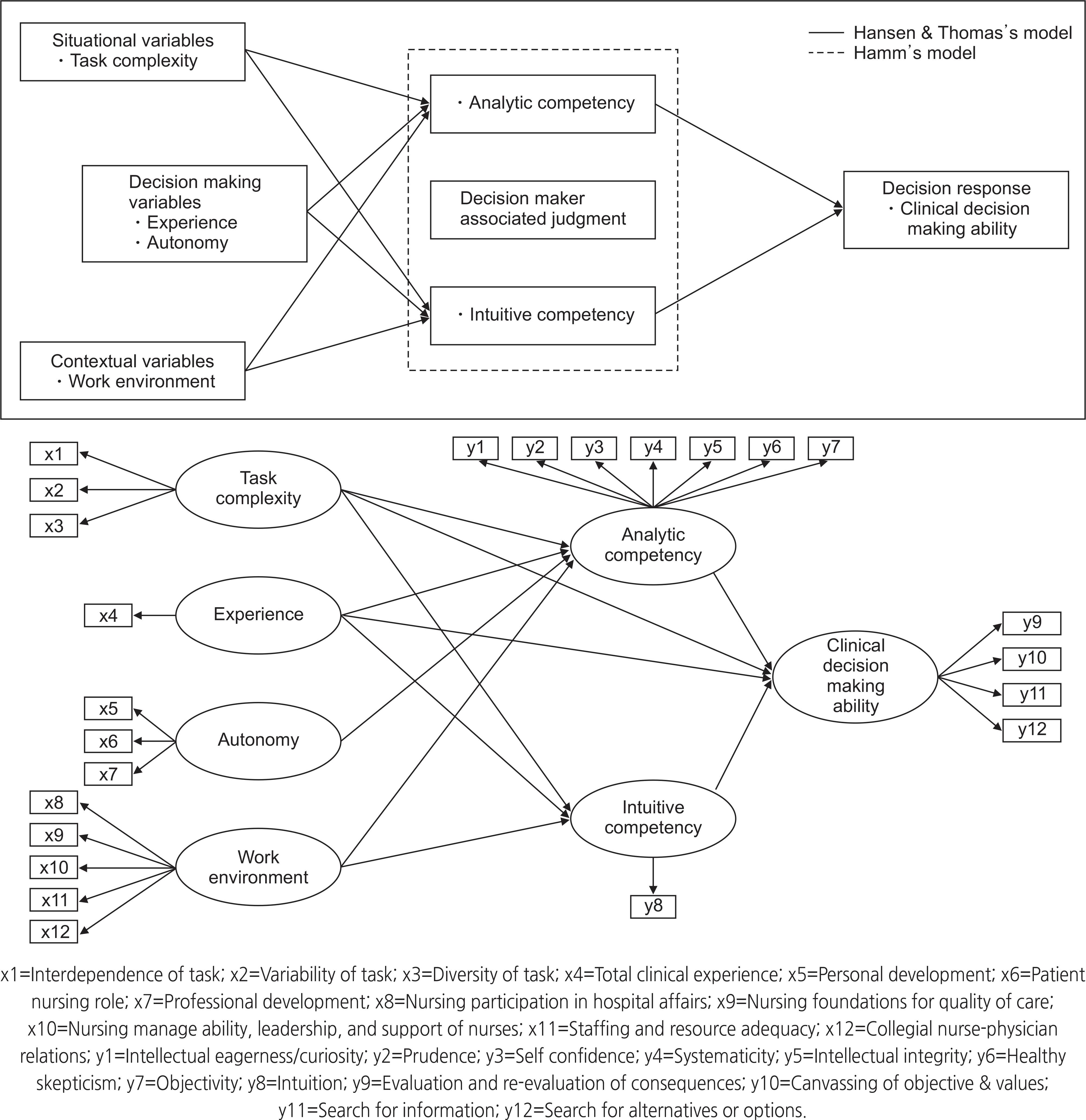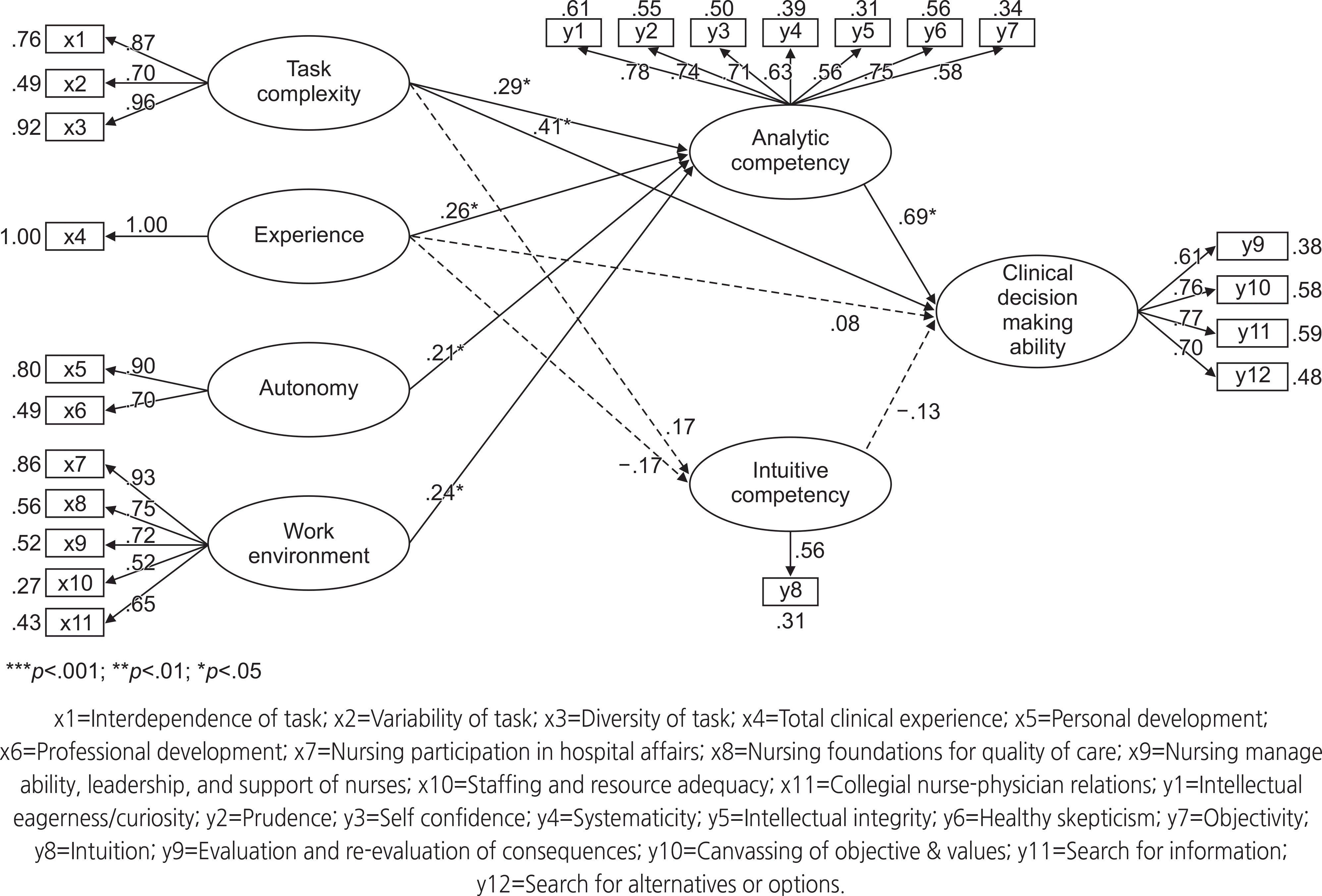Abstract
Purpose
The purpose of this study was to construct and test a hypothetical model of clinical decision-making ability of nurses based on the Decision Making Process model and the Cognitive Continuum theory.
Methods
The data were collected from nurses working at 11 hospitals in Busan, Daejeon, and South Gyeongsang Province from June 30 to August 1, 2017. Finally, the data from 323 nurses were analyzed.
Results
The goodness-of-fit of the final model was at a good level (χ 2/df=2.46, GFI=.87, AGFI=.84, IFI=.90, CFI=.90, SRMR=.07, RMSEA=.07) and 6 out of 10 paths of the model were supported. The clinical decision-making ability was both directly and indirectly affected by task complexity and indirectly affected by experiences, autonomy, and work environment. Specifically, it was strongly directly affected by analytical competency but was insignificantly affected by intuitive competency. These variables accounted for 66.0% of clinical decision-making ability.
References
1. Bucknall TK. Critical care nurses’ decision‐making activi- ties in the natural clinical setting. Journal of Clinical Nursing. 2000; 9(1):25–36. https://doi.org/10.1046/j.1365-2702.2000.00333.x.
2. Thompson C, Cullum N, McCaughan D, Sheldon T, Raynor P. Nurses, information use, and clinical decision making—the real world potential for evidence-based decisions in nursing. Evidence-Based Nursing. 2004; 7(3):68–72. https://doi.org/10.1136/ebn.7.3.68.

3. Banning M. A review of clinical decision making: Models and current research. Journal of Clinical Nursing. 2008; 17(2):187–195. https://doi.org/10.1111/j.1365-2702.2006.01791.x.

4. Bj⊘rk IT, Hamilton GA. Clinical decision making of nurses working in hospital settings. Nursing Research and Practice. 2011; 2011:524918. https://doi.org/10.1155/2011/524918.

5. Chen SL, Hsu HY, Chang CF, Lin ECL. An exploration of the correlates of nurse practitioners’ clinical decision‐making abilities. Journal of Clinical Nursing. 2016; 25(7-8):1016–1024. https://doi.org/10.1111/jocn.13136.

6. Lauri S, Salanterä S. Developing an instrument to measure and describe clinical decision making in different nursing fields. Journal of Professional Nursing. 2002; 18(2):93–100. https://doi.org/10.1053/jpnu.2002.32344.

7. Kim SY. A study on participation in clinical decision making by home healthcare nurses. Journal of Korean Academy of Nursing. 2010; 40(6):892–902. https://doi.org/10.4040/jkan.2010.40.6.892.

8. Lim NY, Yi YJ. Factors on decision-making participation related to clinical experience difference. Journal of Korean Academy of Nursing. 2004; 34(2):270–277. https://doi.org/10.4040/jkan.2004.34.2.270.

9. Lee Y, Gang M, Jung MS. Impact of professional autonomy and nursing work environment on clinical decision making of clinical nurses. Korean Journal of Occupational Health Nursing. 2013; 22(4):285–294. https://doi.org/10.5807/kjohn.2013.22.4.285.

10. Oh I, Kim JH. Impacts of critical thinking disposition and nursing work environment on nurses’ clinical decision making abilities. The Journal of Korean Academic Society of Nursing Education. 2016; 22(3):304–315. https://doi.org/10.5977/jkasne.2016.22.3.304.

11. Hansen AC, Thomas DB. A conceptualization of decision-making: Its application to a study of role-and-situation-related differences in priority decisions. Nursing Research. 1968; 17(5):436–443.
12. Hagbaghery MA, Salsali M, Ahmadi F. The factors facilitating and inhibiting effective clinical decision-making in nursing: A qualitative study. BMC Nursing. 2004; 3(1):2. https://doi.org/10.1186/1472-6955-3-2.

13. Hamm RM. Clinical intuition and clinical analysis: Expertise and the cognitive continuum. Dowie J, Elstein AS, editors. Professional Judgment: A Reader in Clinical Decision Making. New York: Cambridge University Press;1988. p. 78–105.
14. Oh JG. An analysis of the moderating effects of task complexity on the relationship among ease of use, usefulness, and satisfaction of hospital information system [dissertation]. Asan: Soonchunhyang University;2014. p. 1–119.
15. Kim IW. A structure model on head nurse’s leadership [dissertation]. Seoul: Kyung Hee University;2005. p. 1–87.
16. Cho E, Choi M, Kim EY, Yoo IY, Lee NJ. Construct validity and reliability of the Korean version of the practice environment scale of nursing work index for Korean nurses. Journal of Korean Academy of Nursing. 2011; 41(3):325–332. https://doi.org/10.4040/jkan.2011.41.3.325.

17. Scheffer BK, Rubenfeld MG. A consensus statement on critical thinking in nursing. The Journal of Nursing Education. 2000; 39(8):352–359.

18. Hicks FD, Merritt SL, Elstein AS. Critical thinking and clinical decision making in critical care nursing: A pilot study. Heart & Lung. 2003; 32(3):169–180. https://doi.org/10.1016/S0147-9563(03)00038-4.

19. Benner P, Tanner C. Clinical judgment: How expert nurses use intuition. The American Journal of Nursing. 1987; 87(1):23–31.

20. Traynor M, Boland M, Buus N. Autonomy, evidence and intuition: Nurses and decision‐making. Journal of Advanced Nursing. 2010; 66(7):1584–1591. https://doi.org/10.1111/j.1365-2648.2010.05317.x.

21. Kang KJ, Kim EM, Ryu SA. Factors influencing clinical competence for general hospital nurses. The Journal of the Korea Contents Association. 2011; 11(1):284–293. https://doi.org/10.5392/JKCA.2011.11.1.284.

22. Yu JP. The concept and understanding of structural equation modeling. Seoul: Hannrae Publishing Co.;2012. p. 1–391.
23. Bae BR. Structural equation modeling with Amos 21: Principles and practice. Seoul: Chungram Books;2014. p. 80–330.
24. Schutzenhofer KK. The development of autonomy in adult women. Journal of Psychosocial Nursing and Mental Health Services. 1983; 21(4):25–30.

25. Lake ET. Development of the practice environment scale of the nursing work index. Research in Nursing & Health. 2002; 25(3):176–188. https://doi.org/10.1002/nur.10032.

26. Yoon J. A study on the critical thinking disposition of nursing student - focusing on a school applying integrated nursing curriculum -. Journal of Korean Academy of Nursing Administration. 2008; 14(2):159–166.
27. Rew L. Acknowledging intuition in clinical decision making. Journal of Holistic Nursing. 2000; 18(2):94–108. https://doi.org/10.1177/089801010001800202.

28. Beaton DE, Bombardier C, Guillemin F, Ferraz MB. Guidelines for the process of cross-cultural adaptation of self-report measures. Spine. 2000; 25(24):3186–3191. https://doi.org/10.1097/00007632-200012150-00014.

29. Jenkins HM. Improving clinical decision making in nursing. The Journal of Nursing Education. 1985; 24(6):242–243.

30. Baek MK. Relationship between level of autonomy and clinical decision-making in nursing scale of E.T nurse [master’s thesis]. Seoul: Yonsei University;2005. p. 1–89.
31. Shin GG. Structural equation modeling (SEM) with SPSS/Amos 23. 2nd ed. Seoul: Chungram Books;2016. p. 81.
32. Noh KS. A well-informed paper stat SPSS & Amos 21. Seoul: Hanbit Academy;2014. p. 331–351.
33. Park HS, Jung SY. Development of the structural model of adolescent’s risk behavior. Journal of Korean Academy of Nursing. 2011; 41(3):364–373. https://doi.org/10.4040/jkan.2011.41.3.364.

34. Park S, Kwon IG. Factors influencing nurses’ clinical decision making: Focusing on critical thinking disposition. Journal of Korean Academy of Nursing. 2007; 37(6):863–871. https://doi.org/10.4040/jkan.2007.37.6.863.

35. Yeom YH, Ko MS, Kim KK, Kim BY, Min S, Shin MJ, et al. Nursing Management. 6th ed. Paju: Soomoonsa;2017. p. 274–275.
36. Lee JY, Pak SY. Relationship between the practice environment of nursing and critical thinking disposition of nurses in local general hospitals. Journal of Korean Academy of Nursing Administration. 2014; 20(2):145–153. https://doi.org/10.11111/jkana.2014.20.2.145.

37. Park SH. Impact of nursing professional self-concept, clinical decision making ability, critical thinking disposition, professional autonomy of clinical nurse’s. Journal of the Korea Entertainment Industry Association. 2015; 9(4):325–334. https://doi.org/10.21184/jkeia.2015.12.9.4.325.

38. Kim HS. Effects of the nursing process education program on critical thinking dispositions of the nursing students. Journal of the Korean Data Analysis Society. 2015; 17(1):561–574.
39. Choi E, Hwang J, Jang I. Effects of nursing practice environment and self-esteem on critical thinking disposition among clinical nurses. Journal of Korean Academy of Nursing Administration. 2017; 23(2):161–169. https://doi.org/10.11111/jkana.2017.23.2.161.

40. Chilcote DR. Intuition: A concept analysis. Nursing Forum. 2017; 52(1):62–67. https://doi.org/10.1111/nuf.12162.

41. Benner P. From novice to expert: Excellence and power in clinical nursing practice. American Journal of Nursing. 1984; 84(12):1480.

42. Hassani P, Abdi A, Jalali R. State of science, “Intuition in nursing practice”: A systematic review study. Journal of Clini- cal and Diagnostic Research. 2016; 10(2):JE07–JE11. https://doi.org/10.7860/JCDR/2016/17385.7260.

43. Woolley A, Kostopoulou O. Clinical intuition in family medicine: More than first impressions. Annals of Family Medicine. 2013; 11(1):60–66. https://doi.org/10.1370/afm.1433.

Table 1.
General Characteristics of Participants (N=323)
Table 2.
Descriptive Statistics and Confirmatory Factor Analysis of Measurement Model (N=323)
Table 3.
Standardized Direct, Indirect, and Total Effects of the Modified Model (N=323




 PDF
PDF ePub
ePub Citation
Citation Print
Print




 XML Download
XML Download